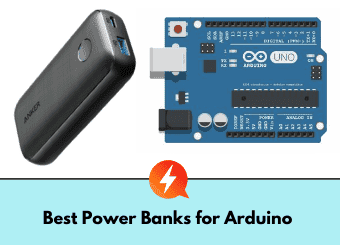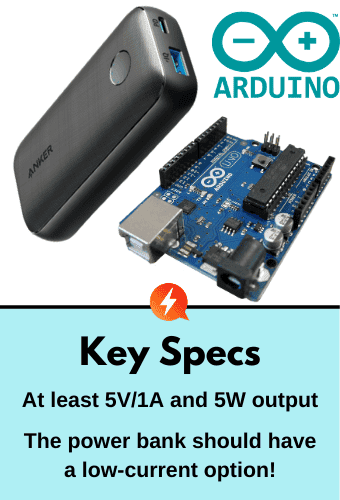In this article, we’re exploring how you can choose the best power bank for Arduino. Some of the main topics included in the article are:

- the power requirements of the Arduino and its various models
- what specs to look at when choosing a portable charger for Arduino
- our top 5 Ardunio power bank picks
Arduino is a standardized hardware platform with processors, interfaces, the ability to expand the hardware inexpensively, and software to develop and upload. Behind it is a modular system for programmers who want to develop hardware-related solutions as quickly as possible. Anyone that wants to create something with microcontrollers, finds Arduino to be a simple system to get started with a microcontroller. Unlike other microcontroller systems, Arduino is very suitable for beginners.
Arduino Power Requirements
The Arduino needs a minimum input voltage of 5V, which in most cases gets transmitted via a USB port. The value for the current depends on the model that you use, but approximately they need a current between 20mA and 50mA, as an Arduino does not power any high-energy components. An Arduino needs around 250mW up to 500mW of power, but this also differs from model to model.
It’s important to mention that if you’re using the Vin pin or the power jack, the recommended input voltage is actually 7V-12V because the onboard regulator needs a higher voltage to properly regulate down to 5V. This is especially relevant if you plan to power additional components from the Arduino’s 5V or 3.3V outputs.
The Arduino can be powered in different ways:
- via the USB port
- via a power adapter and 5.5 mm plug
- via the Vin Pin
- via the Vcc-Pin
Depending on the application, the solutions mentioned offer advantages and disadvantages. Let’s explore each of them:
Powering via USB:
The easiest and most affordable option for the Arduino power supply is by using a USB cable and a USB power supply. This option is particularly interesting if the demands for a stable power supply of the connected devices are rather low. Depending on the load of the Arduino, the voltage at the Vcc Pin can drop considerably. However, the price and the high availability of power sources (mobile phone charging cable, PC, car, etc.) are advantageous.
Powering via power adapter:
The use of a power adapter to supply the Arduino offers above all the advantages of voltage stability. However, in this case, the internal voltage converter of the Arduino is used. As this is uncooled in the standard version of the Arduino, only a very limited power can be passed on to external devices. When choosing a suitable power supply, it should be noted that it has a 5.5mm round plug and provides a voltage between seven and nine volts. Theoretically, it is also possible to use a 12V power supply. However, in this case, the loss of power and therefore the heat development on the voltage converter increases significantly. Another disadvantage is the slightly higher cost of this solution.
Powering via Vin pin:
In addition to the use of the 5.5 mm socket of the Arduino, it is also possible to ensure the energy supply via a pin. This is even necessary for some models, such as the Nano since it does not have a power supply connection. The wiring, however, is rather uncomplicated. The minus pole of the Arduino power supply is connected to the ground pin and the plus pole is to the Vin pin.
Powering via Vcc pin:
Powering the Arduino by means of the Vcc pin is the most complex option. However, it has the advantage that the voltage can be kept stable and higher power can be called up. In this case, however, it is necessary to provide an external operating voltage of five volts. I achieved a very good result by using a nine-volt power supply and a small voltage converter. This option is especially recommended for larger projects, as the voltage conversion takes place outside the Arduino, which becomes just another consumer in the grid. The disadvantages of this option are the slightly higher price and the additional space needed for the voltage transformer.
Key Specs for Portable Chargers that Can Power an Arduino

Here are the optimal specs to power an Arduino properly:
- The minimum output should be 5 Volts and the value for the current depends on the model. Let us take the Arduino Uno as an example. It needs a voltage of 5Volts, a current of between 20mA to 50mAA, and a power of 2Watts. The power bank should at least deliver 1-2A with a power of 5Watts, that should be enough.
- A power bank with a capacity of 2500mAh is able to run an Arduino for 2 days.
Depending on the interval you want to run your Arduino, 50mAh would be enough to run the microchip for 1h, 500mAh for 10h, and 7500mAh for approximately 7 days. These estimations depend on which specific Arduino board is used, how it’s being used, what else is connected to the Arduino, and the efficiency of the power bank itself. Battery life depends on many factors. - Most power banks automatically shut off if the current consumption is below 100mA-200mA. Since Arduino boards need a very low current to run, make sure your power bank has a low current feature, so that it won’t turn off, when an Arduino is connected.
- Another note worth mentioning is to keep your voltage stable. An unstable voltage can cause a very weird behavior of the microcontroller, which we of course want to avoid.
Our Top Picks for the Best Arduino Power Banks
How We Selected The Power Banks
Output Stability: Stability in power output is crucial for Arduino projects. We looked for power banks that offer consistent voltage and current, which is essential for the smooth operation of Arduino boards.
Capacity: The capacity of the power bank is vital, especially for longer projects. We focused on finding power banks that offer a balance between high capacity and efficient power usage.
Build Quality: Durability is key in a power bank used for Arduino projects, as they might be used in various environments. We chose power banks that are robust and can withstand a bit of wear and tear.
Safety Features: Safety is paramount, especially when dealing with electronics projects. We picked power banks that come with built-in protections against overcharging, overheating, and short circuits
1. Zendure PD SuperMini 10000mAh

- Capacity: 10000mAh
- Can power an Arduino for up to: 8 days
- Low-current charging: Yes
- Ports: 1 USB Type A, 1 USB Type C
- USB C output: 5V/3A, 9V/2A, 12V/15A
- Max output: 18W
- Weight: 6.3 oz / 178 g
- Recharging time: 3 hours
Or buy on GeekBuying.com or on Zendure.com
Unboxing video
The Zendure SuperMini 10000mAh is a stylish power bank with a really high build quality. The outer casing is made out of a metal alloy and the design makes it look like it’s been made for the aviation industry.
A very important feature is its trickle-charging ability. This means it’s able to power Arduinos that are drawing in lower amounts of power when most power banks would have automatically shut down. In order to turn on this feature (which is also called “low current charging“), you simply press the power button twice. If you want to deactivate it, then press the power button twice again and it will revert to the classic charging mode.
With a capacity of 10000mAh, the Zendure SuperMini would be able to charge an Arduino for up to 8 days, depending on the model and the software that is run on it.
Review after one year
- Can power Arduinos
- Low current charging feature
- PD charging
- Premium build quality
- Prone to scratches after a long usage period
AUKEY Basix Pro

- Capacity: 20000mAh
- Can power an Arduino for up to: 16 days
- Low-current charging: Yes
- Ports: 1 USB type C, 1 USB type A
- USB C output: 5V/3A, 9V/2A, 12V/1.5A
- Max output: 18W
- Weight: 16 oz / 453 g
- Recharging time: 3.5 hours
Or get it on Bestbuy or on Ebay
The Aukey Basix Pro is a very well-built power bank, maybe the best that Aukey has produced to date. It features a generous 20000mAh capacity, enough to power an Arduino for up to 16 days.
It features only two output ports: one USB type C and one USB type A. But it also comes with wireless charging. So if you want to use this power bank to charge more than your Arduino, then it does offer quite some flexibility in this sense.

What’s quite handy is the fact that is comes with an LCD display screen. This means you’ll always be able to tell the exact charge in the battery. The majority of power banks, on the other hand, have just the classic LED arrangement, which is not accurate at all.
In terms of build quality, this is a sound device. The outer casing is made from a highly resistant plastic. It’s shiny, not prone to smudges or fingerprint marks, and has an overall premium feel to it.
For a 20000mAh power bank, it’s surprisingly compact. You can even carry it in a pocket if need be, not to mention a backpack or purse.
Unboxing video
- Generous capacity
- Foldable kickstand
- Fast recharging time
- LCD display screen
- The kickstand can be difficult to get open
Conclusion
So, let us revise the most important things to consider when powering an Arduino. Make sure you power the microcontroller with stable 5Volts and enough current. Keep in mind that some power banks turn off when the current consumption is low, make sure to check this, it will save you many hours of wondering, why the microcontroller is not doing anything.
Now you are well-informed about how to power an Arduino. It is time to use this knowledge now in practice. Try to power your super cool Arduino project with those tips!
